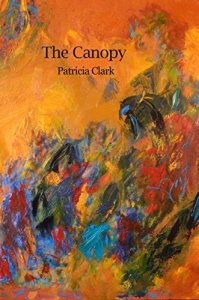Patricia Clark: Review by Anjela Villareal Ratliff

Patricia Clark, The Canopy (Terrapin Books)
In The Canopy, Patricia Clark’s poetry stunningly relays her tragic loss of loved ones. In the poem “Land of Getaway,” she describes the hollow of their absence: “They are bones, tomorrow, / who were our friends . . . the bed is a coffin.” The shock that lingers long after experiencing death is almost palpable in those few words. The book is laden with explosions of powerful lines like these that cut to the bone.
Part of the book laments her departed mother. Feeling orphaned, Clark wonders: “who will be / at my side when I go?” She also addresses a dead sister, regretting that “When she moved away, there was no goodbye.” However, she and another sister are able to grieve together over their “departed red-headed sister.” Throughout the book, we see the poet’s obsession with death and how it began in her childhood years attending funerals at church and “not knowing yet . . . just why / coffins were there.”
Battling overwhelming grief, Clark turns to Mother Nature for answers. She finds that taking frequent strolls through a forest of lively plants, animals, and a river, provides a balm. In the woods, she analyzes all aspects of nature’s transitory themes like a curious child examining the fine details of a fallen leaf, turning it over and over to make sense of every delicate intricacy. Amid the forest’s canopies, she is reminded how “It’s stranger than you can account for, / being alive.” Her ritual walks soon become a metaphor for writing—her necessary medicine.
Clark repeatedly stirs our empathy, while often delighting us with scientific details, noting how trees and humans are locked in the same ephemeral cycle of being a “seed bearing bundle that sends / DNA . . . out in the world to grow again.” Clark encounters the forest’s multifaceted wildness: gentle and beautiful, while at other times harsh, violent, and even ugly—like human life. And in the poem “Artisan,” we confront nature’s unforgiving side in its “broken trees, frozen ground / speaking of the grave.” Seeing repeated evidence of the intricate dance between life and death, she knows she must learn new steps to fall back into pace with the rhythm and dance of the living, where things go on as usual.
Seemingly, dealing with survivor’s guilt, Clark culls over the complexities of having loved and lived with difficult persons she will never see again. The poem “Frontal View of Trees,” exposes the lingering shock of her mother’s freak death, and the regret that she “didn’t die / comforted, at home . . ..” In “Treatise on the Double Self,” Clarke continues her scrutiny: “I’ve spent hours and months trying to know / my mother.” Then, in “Fragrant Cigar Boxes,” she digs deeper into the mother-daughter relationship, remembering how “It wasn’t easy to cook a meal in her kitchen.” The death of loved ones does not mean that one cannot address their shortcomings and the hardships experienced with those individuals after they are gone, and I admire the poet’s frankness as she does just that in poems like these.
Clark confronts her own mortality head-on, as she wrestles with the stony fact that one day she too will be erased. She embraces the realism of “feeling wind, the pelting rain / eroding half your mass.” In lines like these, the reader is nudged to remember that we are all “racing against the clock.”
In the latter part of the collection, light seeps in to even the darkest places, and we begin to see “the melting—solving.” It is the incoming spring that makes the most sense to Clark, and in the title poem, “The Canopy” she describes joy knowing that “Come spring . . . the forest floor blooms,” ushering in a resurgence of life that will blanket the once frozen ground. Aptly concluding in “The End of Grief”: “I’ll let her / go . . . I’ll close my rent heart.” We breathe a sigh of relief too, while simultaneously admiring exquisite lines like that one.
Collectively, the poems in The Canopy take us through the core of deep loss that Clark so lyrically conveys. Although, a few poems are a bit cryptic, and took more than one reading to access their depth and relatedness. In addition, there are times when the melancholy in some poems is almost unbearable. However, Clark beautifully integrates sufficient light and beauty into the overall narrative to compensate for its gloomier aspects.
The Canopy can be of special interest to anyone experiencing grief, and those who enjoy immersion in the broad spectrum of the life-and-death cycle. Clark’s powerful collection traverses the varied landscapes of bereavement, while delicately illustrating how each life is but a thin page in the unending epic of the cosmos.
Anjela Villarreal Ratliff’s poems and photographs have appeared in various literary journals and anthologies, including San Pedro River Review, Pilgrimage Magazine, Interstice, riverSedge: A Journal of Art and Literature, Bearing the Mask: Southwestern Persona Poems, The Crafty Poet II: A Portable Workshop, and The Practicing Poet: Writing Beyond the Basics.